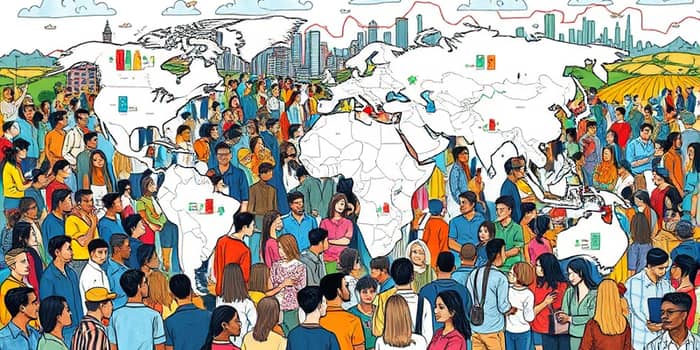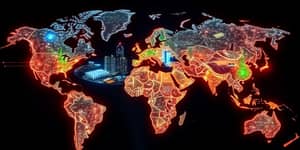In an interconnected world, understanding the interplay between population shifts and market forces is essential for businesses, policymakers, and communities alike.
Understanding Global Population Trends
The global population continues to evolve at a rate of approximately 0.85% per year in 2025, a marked slowdown from recent decades.
Today’s 8.2 billion people are unevenly distributed: nearly 60% reside in Asia, Africa’s share is rapidly increasing, and Europe’s proportion is in decline.
Population density hovers around 50 people per square kilometer worldwide, yet stark contrasts exist between densely packed urban centers and sparsely populated regions.
Notably, India overtook China in 2022, and forecasts predict a peak global population of 10.3 billion by 2084.
Regional Demographics and Market Implications
Population dynamics vary widely by region, creating distinct opportunities for targeted strategies.
Africa’s median age of 19 signals a youthful workforce swelling in the coming decades, whereas Europe’s median age of 43 highlights an aging society coping with higher dependency and healthcare costs.
In Asia, rapid urbanization has propelled over half the continent’s residents into cities, amplifying demand for infrastructure, housing, and mobility solutions.
By 2100, Sub-Saharan Africa and parts of South Asia will account for more than 60% of global growth, driven by high fertility rates in countries like Niger and persistent declines in mortality rates.
Age Structure, Urbanization, and Labor Trends
A balanced workforce is critical to sustaining economic vitality. Yet many developed nations face labor shortages as birth rates fall below replacement levels.
Urbanization exceeding 55% globally has concentrated consumption in metropolitan hubs, fueling sectors from digital services to real estate.
Meanwhile, migration continues to reshape labor markets: young migrants bolster aging societies, while climate-driven relocations add complexity to planning and resource allocation.
Opportunities and Challenges for Businesses and Policymakers
Recognizing demographic shifts early allows organizations to innovate and adapt products and services to evolving needs.
- In aging markets, invest in eldercare technology, healthcare infrastructure, and financial planning services.
- In youth-dominated regions, focus on education platforms, job-creation initiatives, and affordable consumer goods.
- In rapidly urbanizing areas, prioritize sustainable housing, smart mobility solutions, and renewable energy.
However, challenges loom large: failure to integrate migrants, address urban inequality, or manage environmental impacts risks social unrest and economic stagnation.
Practical Steps for Navigating Demographic Change
To harness demographic trends, stakeholders can adopt data-driven decision-making processes that reflect real-time population analytics.
- Leverage predictive modeling to anticipate market demand and resource needs.
- Forge partnerships between governments, private sector, and NGOs to build resilient urban infrastructure.
- Implement inclusive policies that empower women and youth through education and entrepreneurship.
By aligning investment with demographic forecasts, enterprises and communities can unlock a sustainable growth trajectory.
Looking Ahead: Preparing for Future Shifts
Forecasts indicate a plateauing global population after mid-century, yet regional divergences will persist.
Technological advances—automation, remote work, AI-driven healthcare—will interact with demographic realities to redefine labor markets and consumption patterns.
Climate change remains a wildcard: rising sea levels and extreme weather events could spur new waves of migration, testing the adaptability of cities and nations.
Conclusion
Understanding the intricate tapestry of demographics and market dynamics is more than an academic exercise; it is a roadmap to resilient economic planning and inclusive growth.
By embracing demographic intelligence, businesses can innovate responsibly, governments can craft effective policies, and societies can thrive amid change.
The time to act is now: use these insights to shape a future that benefits all generations and preserves our shared planet.
References
- https://www.pewresearch.org/short-reads/2025/07/09/5-facts-about-how-the-worlds-population-is-expected-to-change-by-2100/
- https://www.statista.com/statistics/262879/countries-with-the-largest-population/
- https://www.macrotrends.net/global-metrics/countries/wld/world/population
- https://en.wikipedia.org/wiki/Demographics_of_the_world
- https://blogs.worldbank.org/en/opendata/world-population-day--trends-and-demographic-changes
- https://www.worldometers.info/world-population/
- https://www.worldometers.info/world-population/population-by-country/
- https://www.visualcapitalist.com/mapped-when-each-country-will-reach-its-population-peak/










